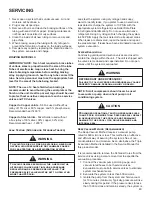
SERVICING
40
Ground Test
If fuse, circuit breaker, ground fault protective device, etc.
has tripped, this is a strong indication that an electrical
problem exists and must be found and corrected. The
circuit protective device rating must be checked and its
maximum rating should coincide with that marked on the
equipment nameplate.
With the terminal protective cover in place, it is acceptable
to replace the fuse or reset the circuit breaker
ONE TIME
ONLY
to see if it was just a nuisance opening. If it opens
again,
DO NOT
continue to reset.
Disconnect all power to unit, making sure that
all
power legs are open.
1. Carefully remove the compressor terminal protective
cover and inspect for loose leads or insulation breaks in
the lead wires.
2. Disconnect the three leads going to the compressor
terminals at the compressor or nearest point to the
compressor.
3. Check for a ground separately between each of the
three terminals and ground (such as an unpainted tube
on the compressor). If there is any reading of continuity
to ground on the meter, the compressor should be
considered defective.
4. If ground is indicated, replace the compressor.
WARNING
Damage can occur to the glass embedded terminals if the
leads are not properly removed. This can result in terminal
and hot oil discharging.
Compressor Ground Test
Unloader Test Procedure with Comfort Alert™
Unitary (UC) Control Diagnostics
If you suspected that the unloader is not working, the
following methods may be used to verify operation.
1. Operate the system and measure compressor
amperage. Cycle the unloader on and off at ten second
intervals by applying and removing Y2 voltage to the
module. Wait five seconds after power is applied to Y2
before taking a reading. An increase in compressor
amperage should be observed when switching from
part-load to full-load and a reduction in compressor
amperage should be observed when changing from
full-load to part-load. The percent change in current
depends on the operating conditions and voltage.
2. If Step 1 does not give the expected results remove
the solenoid plug from the compressor and with the
unit running and the thermostat calling for Y2 to be
energized test the voltage output at the plug with a
dc voltmeter. The reading should be 4 to 18 VDC
for Comfort Alert. If not, unplug the harness from
the module and check voltage at the “High” pins of
the module. The module will not power the unloader
solenoid if the compressor is not running.
3. If the correct DC voltage is at the control circuit molded
plug measure the unloader coil resistance. Shut off
power and remove the control circuit molded plug from
the compressor and measure te unloader solenoid
coil resistance. If the coil resistance is infinite, zero, or
grounded, the compressor must be replaced.
Locked Rotor Test
If fuse, circuit breaker, ground fault protective device, etc.
has tripped, this is a strong indication that an electrical
problem exists and must be found and corrected. The
circuit protective device rating must be checked and its
maximum rating should coincide with that marked on the
equipment nameplate.
Before checking for locked rotor, the compressor terminals
should be checked for open windings (see S-17A
Resistance Test) and the run capacitor and start capacitor
(if used) should be checked thoroughly (see S-15 Checking
Capacitor).
Содержание ASXC16
Страница 4: ...PRODUCT IDENTIFICATION 4 ...
Страница 5: ...PRODUCT IDENTIFICATION 5 ...
Страница 70: ...SERVICING 70 PCBHR104 PCBHR105 ...
















































